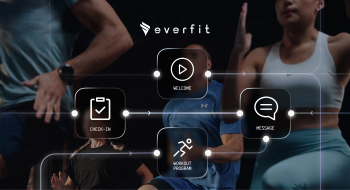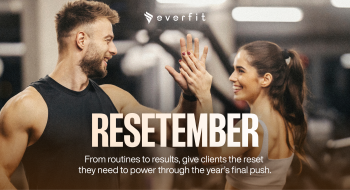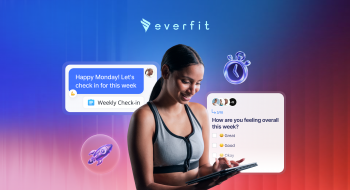While signing new clients is exciting, keeping them committed and engaged for the long run is often the bigger challenge. If you’re struggling with how to retain personal training clients, you’re not alone.
Many trainers lose clients due to stalled progress, a lack of motivation, not building strong enough relationships, or simply because they find a better option, a better training experience. In this blog, we’ll cover practical client retention strategies for personal trainers that get your clients to come back.
Why Retaining Clients Should Be Your Priority?
Think about it: every time a client leaves, you’re not just losing a session but months of potential income, progress, and referrals. On the other hand, when you retain a personal training client long-term, you increase their lifetime value, reduce your churn rate, and spend less time scrambling to fill empty slots.
Retention Drives Sustainable Income: When clients stick with you, you build recurring revenue. This increases ARPU (Average Revenue Per User) and boosts your lifetime value (LTV) per client with no extra marketing cost required.
Reduces Churn and Revenue Gaps: Low client turnover means less stress to fill slots. This stabilizes your calendar with committed clients.
Drive Natural Referrals: Happy long-term clients are walking testimonials. They fuel referral programs, give glowing reviews, and boost social proof, reducing your need to constantly chase leads.
Progress and Results Require Time: Long-time clients ensure you can apply structured techniques, such as periodization, progressive overload, and regular reassessment, to consistently show results over time. Short-term clients (4-8 weeks) can quickly lose their progress.
Support transition from in-person to hybrid or online coaching: Consistent clients allow you to scale easily. Convincing them to continue with your guidance from afar is much easier than convincing a new client who is unfamiliar with your coaching and training style.
Strategy 1: Build Thriving Relationship & Communication
First impression matters! Don’t let a potential client slip away by showing a lack of support, care, or clarity.
Tip 1: Maintain open communication
Clients stay when they feel seen, heard, and supported. Create space for two-way dialogue, not just instructions. Ask for feedback, listen actively, and check in on both physical and emotional progress.
✅ Pro Tip: This is some ready-to-use communication techniques that can help with personal training retention based on psychology.
Motivational interviewing: It’s a client-centered technique that helps you guide clients to discover their own reasons for change, instead of telling them what to do. It builds trust through empathy, active listening, and open-ended questions.
How to use it:
- Ask reflective questions: “What’s been getting in the way of your workouts?”
- Affirm their strengths: “You’ve been super consistent despite your schedule, that says a lot.”
- Avoid judgment or persuasion. Let them talk, and you reflect.
Self-Determination Theory (SDT): This client retention tactic encompasses 3 angles: autonomy, competence, and relatedness to build emotional safety.
How to use it:
- Give clients choices in exercises or check-in frequency → supports autonomy
- Celebrate small wins and progress photos → builds competence
- Show genuine interest in their lives → strengthens relatedness
Tip 2: Don’t just talk about Sets & Reps
Show clients you care by remembering details about their lives, like hobbies, birthdays, or upcoming events. Follow up with a quick text or voice message outside of sessions. These small gestures create a personalized communication that drives loyalty and long-term commitment.
✅ Pro tip:
- Keep a short “client notes”
- Leveraging the sense of belonging by including them in the right fitness and health community. For example, introduce clients to one another who share the same love for running, then build a running challenge for them.
Tools like Everfit Personal Training Platform can help you with this, from direct 1-1 messaging, storing client notes, to managing community challenges.
Strategy 2: Drive Motivation
Ensure your clients consistently return with the right touch and timely support, so they don’t feel left out or behind.
Tip 1: Set clear goals from the start
Clients are most likely to drop off in the first 60 days, often due to confusion, mismatched expectations, or lack of progress. This is why you need to bring clarity from the very beginning.
What you need to do:
- Refine your onboarding process with a detailed assessment to make sure you understand their needs.
- Set SMART goals that align with those needs.
- Explain your coaching style and program structure. You would want to mention the expected results, as well as the training, cancellation, and rescheduling policies, upfront.
- Walk clients through a session structure so they understand their target for each day.
Clear communication like this builds trust and keeps clients focused on achievable milestones.
✅ Pro-tip:
- Send a recap email after your discussion so everything is documented and professional.
- Highlight small wins or tie them with micro-landmarks (such as improved mood, more energy, and strength gains) so clients can embrace new, ambitious fitness goals and regain their confidence. This is also known as the “fresh start” technique in psychology, which is particularly effective during the initial client onboarding weeks.
Tip 2: Always track progress
Tracking progress is more than just recording weights lifted. Show clients how they’re improving not just physically, but also in energy, sleep, stress management, and overall well-being. This is called the intrinsic motivation, which can be a dopamine boost to fitness clients.
When they feel the impact of your coaching in their daily lives, they’re more likely to stick with it.
✅ Pro tip:
- Use progress photos and body composition reports to track physical changes.
- Snuggle in some questions, such as “I bet you had a good sleep last night after the leg session?” or “How is your eating recently?” or “Do you still feel stiff after the workout?” during your check-ins to tackle the wellness benefit. By letting them express themselves, you can reinforce their personal growth and enjoyment.
Another way to track wellness improvement is by using the Habit Tracker and Sleep Monitor, which is also available on Everfit.
Tip 3: Foster a supportive community
There’s no better way to increase personal training client retention and boost coming back than peer-to-peer support. Having a community gives clients a sense of accountability and belonging to something. Of course, this isn’t applied to every client. Some prefer to train privately. If you want to be careful, check with them first.
A community also allows clients to see how others are training with you, giving them more confidence in your coaching. Activities like fitness challenges, group workouts, or even a private group chat can provide them with space to cheer each other on.
✅ Pro-tip: Don’t create a general community, make it better with:
- Micro fitness communities that target a theme or shared goal instead of one big group. For example, a “Weight Lost Team” or “Road to Summer Marathon” can work.
- “Peer accountability” with occasional and free group sessions, allowing clients to guide and learn from each other.
- Referral program with community perks, such as granting them extra points when they invite a friend to join the fitness challenge.
Not so many tools can do a fitness challenge with leaderboards and an engaging community forum like Everfit!
Strategy 3: Reward loyalty
A simple yet powerful tactic in client retention strategies for personal trainers. Treating long-term clients with a more tailored approach and dedication will let they know that their support is appreciated.
✅ Here’s what you can do:
- Loyalty program with milestone rewards: Discount on the next program, complimentary personal sessions after 3 months of subscription, and a special gift for loyal clients after 1 year of training with us.
- Create an on-demand resource filled with practical training, nutrition, and wellness tips: This can be an add-on for long-time clients, expanding your personal touch outside the gym.
Strategy 4: Provide Personalized Experience
Let’s go back to the core! Clients won’t even stay if your program is not good enough, no matter how excellent a communicator you are.
Tip 1: Personalized Training Plans
Ditch the one-size-fits-all plans. Your clients need an approach that matches their goals, fitness level, and lifestyle. Additionally, regularly updating your program with fresh routines or introducing new techniques can help prevent boredom and spark curiosity.
✅ Pro-tip: A tactic to make your program much more interesting, and clients will stick longer, is structuring a training program into blocks or periodization that are not only physiologically effective but also psychologically manageable
How to do it:
- Strength phase: Gradually increase intensity through progressive overload to make training more challenging, allowing clients to experience continuous muscle growth and feel proud of their progress.
- Conditioning phase: Incorporate cardio sessions, high-intensity intervals, or HIIT circuits to enhance endurance and agility. Clients feel they are getting stronger day by day.
- Deload week: Lightweight sessions to avoid muscle fatigue and not let clients feel too overwhelmed or challenged.
You can also design early sessions with “easy wins” in the first 30 days (PR on form, small strength jump, or improved mobility) to hook them quickly and reinforce trust in your coaching.
Designing a program architecture like this, with nutrition and habit coaching, can be hard to manage on spreadsheets. An intuitive workout builder like Everfit can help, even better with automated check-ins, so you don’t have to chase clients all the time.
👉 Additional guide on making an effective personalized plan:
- RIR and RPE in Periodization Training: Meaning, Benefits, How to Use
- Crafting Personalized Nutrition Plans: A Coach’s Comprehensive Guide to Tailored Success
- Essentials of Program Design for Fitness Coaches
Tip 2: Regular and practical check-ins
A key part of how to retain clients as a personal trainer is showing up even when you’re not in the gym together. Regular check-ins through texts, emails, or your training app remind clients that you’re invested in their progress. These touchpoints keep them engaged, supported, and accountable, which reduces churn and strengthens trust.
✅ Pro Tip: You can schedule a consistent check-in cadence, such as weekly progress photos or post-workout reviews, automatically on Everfit to receive feedback, track progress, and adjust plans quickly.
Tip 3: Provide ongoing education
Don’t just be a personal trainer; establish yourself as a trusted source for training, nutrition, and wellness for your clients. This not only adds value to your offer but also fosters deeper trust and enhances the personal training retention rate. They know they are in good hands, both on and off the gym floor.
✅ Pro Tip: Build yourself a library of practical info:
- Self-training tips.
- Nutrition tips, meal recipes, or guides on supplements.
- Wellness tips include stress management, improving sleep, and a habit-forming framework.
You don’t want to be spammy, so only send them when the information is relevant. For example, a list of highly nutritious French dishes before they go on vacation to France is a nice and thoughtful touch, helping them stay on track.
Low seasons, such as holidays or summer vacation, can increase the drop-off rate and make it harder to keep clients engaged. Here are some specialized tips to encourage more comeback post-vacation.
With Everfit, you can store every document, PDF, or link without losing them and send them to clients with one click. Your client can access this on-demand Netflix-style fitness hub anywhere, anytime, even when they’re offline.
Business tactics to avoid high churn in personal coaching
You have done everything you can to ensure the best possible experience for your clients, but drop-offs can still occur. Sometimes you can safeguard your business with certain tactics.
Set up a tiered package with a low price and a short program: Clients can test your services before making a long-term commitment. This lowers the entry barriers and allows both you and them to determine the best coaching and training method.
👉 Also read: How to Launch a Monthly Subscription Model as a Personal Trainer
Add Pause options: Clients may go on vacation, take a break, or experience health issues. Having a flexible pause option (up to 30 or 60 days) can prevent outright cancellation and ensure your revenue. On the other hand, you have to plan for their welcome back sessions. Here are some tips to bring clients back stronger.
Flexible cancel policy: Instead of strict penalties, use a dynamic cancellation policy that balances flexibility with accountability. For example: 24-hour notice = reschedule credit, late cancel = reduced credit. You should also set your refund policy for special cases or be open to membership downgrades if there’s a package that is more suitable for their finances.
Be clear about commitment terms: Having clients sign upfront commitment contracts (e.g., 3–6 months) reduces drop-offs in the first 90 days. It sets expectations while leveraging accountability. You can also refuse their refund request after a certain weeks.
The key here? Communicate all of these with your clients upfront with clarity. This protects both you and your clients.
Managing your client retention the right way
You’ve gotten all your strategies, all your tactics, all your techniques; now it’s time to set up a system that helps you spot early signals and act before clients walk away.
This is where data and analytics come in. By tracking key metrics, you can predict churn and adjust your approach in time.
Start with simple numbers: the attendance rate for in-person training and the number of workouts completed for online training. A sudden dip in consistency is often the first red flag. A standard personal training platform, such as Everfit, typically comes with a detailed dashboard.
You can take a step further with cohort analysis and engagement scoring tools, which show patterns across groups of clients over time. Running quick NPS surveys with your client feedback helps you gauge satisfaction and loyalty: what is working and what is not. When you combine these tools with a focus on client lifetime value (LTV), you’ll know exactly where to intervene to reduce churn and strengthen loyalty.
✅ Pro Tip: If your refund exceeds 10% of net revenue, this is a good time to act quickly. Get as much feedback as possible.
Wrapping Up
Clients don’t just stay because you deliver good workouts—they stay because you’ve built an environment where:
- Their progress is measured
- Their needs are anticipated
- Their loyalty is rewarded
- Their community is nurtured
The most successful trainers don’t just coach workouts—they design ecosystems that clients never want to leave.
FAQ
- What is the average client retention rate of personal trainers?
The standard retention rate for personal trainers is approximately 75% to 80%. However, depending on the seasons, such as summer vacation or year-end holiday, the numbers can drop to 70%.
- Is 90% a good retention rate?
90% is a goal retention rate for many personal trainers. This number means your current clients are satisfied with your coaching.
- How many clients are enough for a personal trainer to keep the best retention?
There isn't a defined number. It depends on your service. For low-ticket coaching, it can reach 50 to 100 clients at the same time. For high-ticket coaching, such as one-on-one, the ideal number of clients should be around 10 to 25 to optimize your effort and achieve the best retention.
- How long do clients stay with a personal trainer?
It's recommended to work with a client for at least 3 to 6 months to fully understand their demand and see the results. A shorter timeframe may not see impactful results, indicating a low retention rate and satisfaction score.
- How to reduce churn during holidays and vacations for personal trainers?
Engage with clients outside the gym, regular check-in, and constant remind them about their goals, provide insightful health and fitness tips related to their destination vacation spot or holiday are simple ways you can do to avoid drop-offs and encourage comeback.















